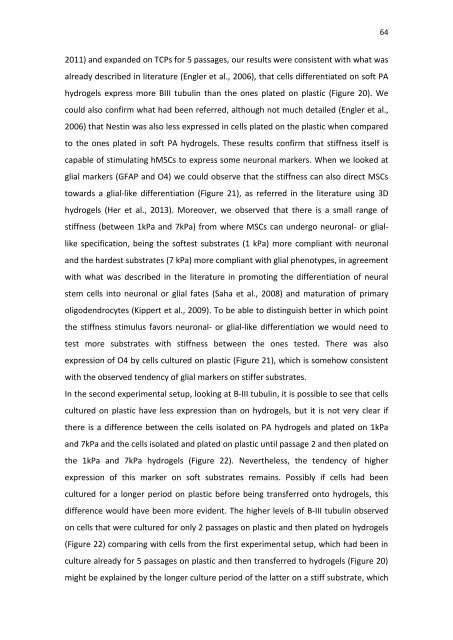DEPARTAMENTO DE CIÊNCIAS DA VIDA ... - Estudo Geral
DEPARTAMENTO DE CIÊNCIAS DA VIDA ... - Estudo Geral
DEPARTAMENTO DE CIÊNCIAS DA VIDA ... - Estudo Geral
Create successful ePaper yourself
Turn your PDF publications into a flip-book with our unique Google optimized e-Paper software.
64<br />
2011) and expanded on TCPs for 5 passages, our results were consistent with what was<br />
already described in literature (Engler et al., 2006), that cells differentiated on soft PA<br />
hydrogels express more BIII tubulin than the ones plated on plastic (Figure 20). We<br />
could also confirm what had been referred, although not much detailed (Engler et al.,<br />
2006) that Nestin was also less expressed in cells plated on the plastic when compared<br />
to the ones plated in soft PA hydrogels. These results confirm that stiffness itself is<br />
capable of stimulating hMSCs to express some neuronal markers. When we looked at<br />
glial markers (GFAP and O4) we could observe that the stiffness can also direct MSCs<br />
towards a glial-like differentiation (Figure 21), as referred in the literature using 3D<br />
hydrogels (Her et al., 2013). Moreover, we observed that there is a small range of<br />
stiffness (between 1kPa and 7kPa) from where MSCs can undergo neuronal- or gliallike<br />
specification, being the softest substrates (1 kPa) more compliant with neuronal<br />
and the hardest substrates (7 kPa) more compliant with glial phenotypes, in agreement<br />
with what was described in the literature in promoting the differentiation of neural<br />
stem cells into neuronal or glial fates (Saha et al., 2008) and maturation of primary<br />
oligodendrocytes (Kippert et al., 2009). To be able to distinguish better in which point<br />
the stiffness stimulus favors neuronal- or glial-like differentiation we would need to<br />
test more substrates with stiffness between the ones tested. There was also<br />
expression of O4 by cells cultured on plastic (Figure 21), which is somehow consistent<br />
with the observed tendency of glial markers on stiffer substrates.<br />
In the second experimental setup, looking at B-III tubulin, it is possible to see that cells<br />
cultured on plastic have less expression than on hydrogels, but it is not very clear if<br />
there is a difference between the cells isolated on PA hydrogels and plated on 1kPa<br />
and 7kPa and the cells isolated and plated on plastic until passage 2 and then plated on<br />
the 1kPa and 7kPa hydrogels (Figure 22). Nevertheless, the tendency of higher<br />
expression of this marker on soft substrates remains. Possibly if cells had been<br />
cultured for a longer period on plastic before being transferred onto hydrogels, this<br />
difference would have been more evident. The higher levels of B-III tubulin observed<br />
on cells that were cultured for only 2 passages on plastic and then plated on hydrogels<br />
(Figure 22) comparing with cells from the first experimental setup, which had been in<br />
culture already for 5 passages on plastic and then transferred to hydrogels (Figure 20)<br />
might be explained by the longer culture period of the latter on a stiff substrate, which
















